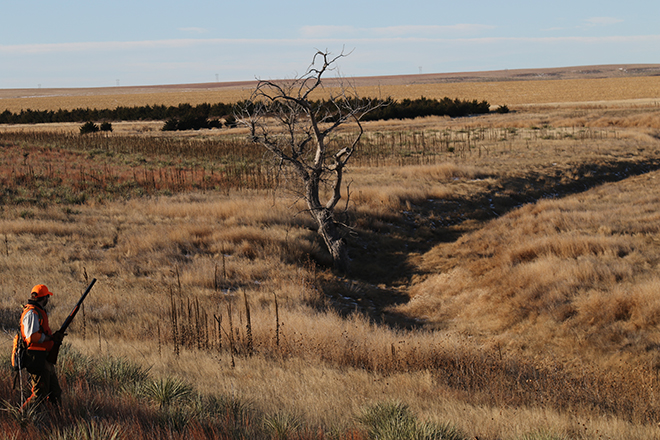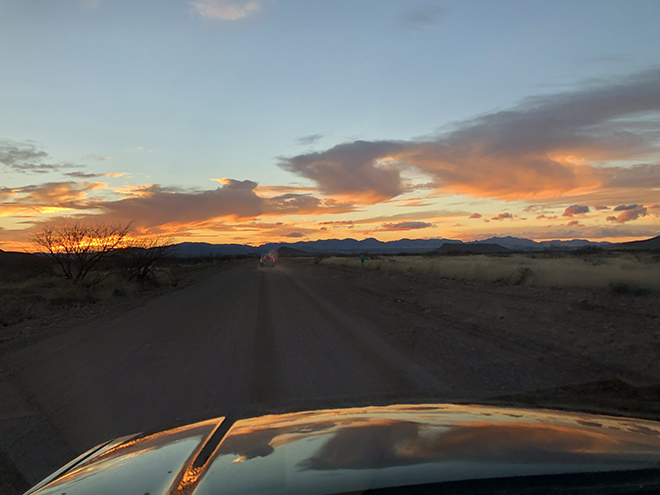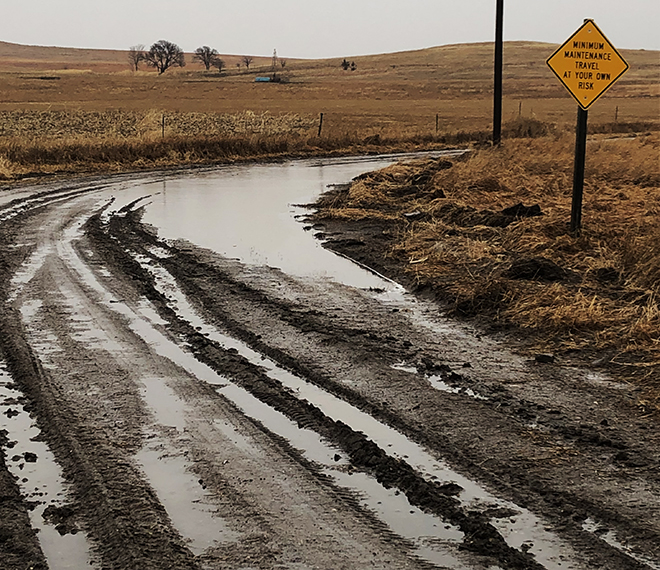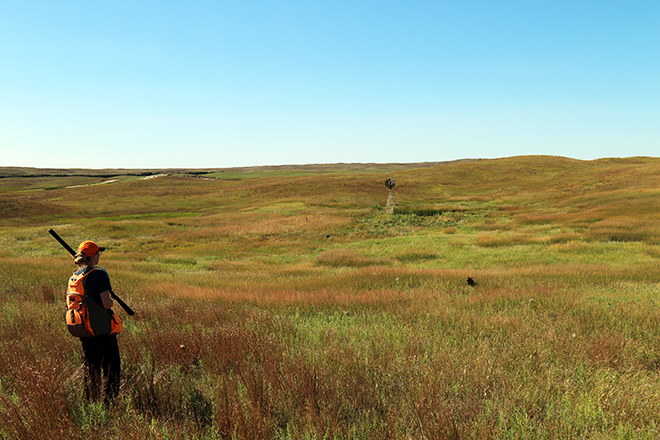By Chad Love
Everyone has a dream, right? Some goal they want to accomplish...someday. Running a marathon, climbing a mountain, sailing across the ocean.
Sometimes we’re able to scratch one off the list as life allows. And sometimes we’re just left, well...dreaming.
For bird hunters, those dreams usually involve feathers, dogs, and travel to wild, distant lands to pursue birds they rarely, if ever, get the chance to hunt.

Of course, one hunter’s dream bird is another hunter’s normal quarry. It’s all just a matter of geographic perspective. What’s routine for a Minnesota woodcock hunter is a rare bird (so to speak) indeed for a southern Arizona desert quail hunter, and vice versa. That’s what makes dreams so personal.
But the one thing all dreams – fulfilled dreams, at least – have in common is the arc of their evolution; from a rough, vaguely-defined idea into a detailed plan of attack.
For me, the tools I use to formulate and then carry out that plan of attack have changed dramatically over the years.
How dramatically? Well, when I first started bird hunting way back when (When, exactly, is when? Let’s just say parachute pants were in fashion at the time...) my buddies and I had a rusted-out Datsun, a torn and grimy gas station state road map, and a vague notion of where we wanted to end up.
And more often than not, where we actually ended up was nowhere near where we intended to end up. Such was life when you were young, clueless, and living in the Stone Age of the late 20th Century.

Eventually, however, as I got older, and perhaps a little wiser, I began adding to my hunt-planning tool chest. I finally figured out the difference between north, south, east, and west. I learned how to use better, more specialized, and more detailed maps, and I actually started arriving at hunting destinations I had intended to arrive at rather than crashing some unsuspecting outdoor wedding party in the wrong state.
At least most of the time. I still got lost, of course, because I am genetically programmed to get lost. It’s an integral part of who I am, an entwined part of my DNA. But my batting average was high enough that I felt reasonably sure that when I set out for that super-secret spot, I’d get there...probably.
Which is all a meandering, long-winded way of admitting that I am – or at least I used to be – a navigational Luddite who never even looked at the onX app before last season.
Why? Because I liked maps. I was comfortable with maps. I disliked (and still dislike) smart phones (because they’re smarter than I am) and I am sure that if phones could feel, the feeling would be mutual. I saw no need to clutter my life with another layer of overly complicated technological distraction.
That is, until I was on a hunt early last season with a buddy, trying to navigate the Byzantine maze that is the Kansas county road system in search of overlooked walk-in hunting areas.

While I was fumbling for my reading glasses trying to decipher the microscopic text and lines on my public-access map, my buddy was not only giving me detailed directions on how to get to the next walk-in area, he was looking over the satellite imagery of the area and giving me a comprehensive scouting report on the area: what kind of cover it contained, what the other fields around it looked like, whether there was water on the area, elevation, where we could park, and how we should hunt the area to maximize our chances of finding game.
I was, as the British say, gobsmacked. I hadn’t even figured out which intersection we were on yet, and my buddy had already planned out our hunt strategy, all just by utilizing his onX app.
Needless to say, the onX app was downloaded to my phone the next day, and my hunting strategy hasn’t been the same since.
Do I still use maps? Sure, I keep them in the truck, more so for tradition than anything, if I’m honest. onX has become my primary scouting and hunt navigation tool.
With onX I know exactly what a parcel of land looks like, what it has on it, what it’s surrounded by, and whether it’s worth driving to. If it is worth driving to, onX navigates me there unerringly and with more precision and certainty than my maps ever could.
It has truly been a game-changer to this technologically challenged Gen X dinosaur. Would I leave home on a hunting trip without it? Only if I wanted to get lost.
And speaking of getting lost – figuratively, not literally – here are 11 birds, and 11 bird dream starters.
Consider it an upland dream starter kit, minus the directions.
You will get no detailed maps, no insider information, no sure-thing tips for finding the birds listed below. That’s what the combination of onX and your brain is for.
This is merely a giant, glowing arrow in the sky pointing toward the possibility of adventure, with a dialogue bubble that reads “Birds in This General Direction! The Rest is Up to You.”
And if you’re a real bird hunter, that’s the way you like it, anyway...

Ring-necked Pheasant
State: Iowa
Region: North/North-Central
There are any number of good reasons why the pheasant is the most popular upland bird in the nation. It’s widespread, populous, gaudy, cunning, devious, and beautiful. To watch a rooster erupt into the sky is to witness the visual definition of “raucous.” And while states like South Dakota get the lion’s share of pheasant glory these days, Iowa has quietly remained one of the top states for our most unabashedly un-quiet birds. Why Iowa? A long and proud pheasant-hunting tradition, ample public land, and perhaps a little less glaring spotlight than other states. Iowa manages some 390,000 acres of wildlife management areas across the state, plus another 22,000 acres enrolled in the state’s public-access program. The northwest and north-central parts of the state are historically the state’s top-producing areas, and while hunting pressure can be a factor, for those willing to hunt hard, hunt smart, and be flexible, Iowa is a sleeper choice for those who dream of bagging their first longtail.
Bobwhite Quail
State: Kansas
Region: Central
If you’re a public-land hunter and you’ve always dreamed of bagging a bobwhite quail, then there’s no better state in which to do it than Kansas. With a gold-standard walk-in hunting program that offers over a million acres of hunting access, plus some truly fine wildlife management areas, you should be able to find bobwhites just about anywhere in Kansas. Having said that, the middle third of the state offers the best combination of bobwhite numbers, a high concentration of walk-in areas, and the chance to bag roosters and greater prairie chickens as bonus birds. The Kansas quail season usually starts in early November and runs through the end of January, so there’s plenty of time to pick your dream date, too.
Scaled Quail
State: New Mexico
Region: Southwest
If ever there was an underappreciated upland state, it’s New Mexico. It’s one of the few places you can hunt four of our six species of quail, but it’s the scaled quail that is the most numerous and the most hunted. If you’ve always dreamed of hunting this speedy desert runner, the land of Enchantment is enchanting, indeed. The southeastern part of the state has the best mix of public land and bird numbers, but like all desert quail, their populations are highly dependent upon weather, which in the desert is always highly variable. The Bureau of Land Management (BLM) oversees a big chunk of southeastern New Mexico, and some of the best scaled quail hunting can be found on these BLM tracts. This is big, empty, spectacular, and often harsh country. Dreams can be made here, or just as easily crushed. But that’s bird hunting, right?
Sharp-tailed Grouse
State: North Dakota
Region: North-Central
If there is an American Outback, surely part of it must reside in North Dakota. This sprawling, sparsely-populated prairie state stretches to the horizon, and it’s a good bet that no matter where your eyes fall, they will gaze upon some type of upland habitat. But if sharptails, those iconic and beloved prairie icons, are your dream, western North Dakota has all the makings for a dream adventure. The area offers excellent sharptail hunting, light hunting pressure, and a plethora of public land on which to chase birds. The giant Little Missouri Grasslands, at over one million acres the largest single grassland parcel in the nation, contains more ground than you could hunt in a lifetime. And the North Dakota PLOTS (Private Land Open to Sportsmen) program offers even more. It’s an embarrassment of riches ripe for the dreaming.
Greater Prairie Chicken
State: South Dakota
Region: North-Central
Pheasants may rule the roost in South Dakota, but if the challenge of native prairie grouse has more appeal than the cackling gaudiness of roosters, here’s a dream starter tip: it’s not against the law to go to South Dakota and ditch the parrots (see what I did there?). In fact, if your dream is to bag a greater prairie chicken, this is a mighty fine place to do so. With over five million acres of publicly accessible land statewide, you will not lack for opportunity. South Dakota has a veritable acronym soup of private-land lease programs, from walk-in areas to CREP to CHAP to COOP, and of course Ft. Pierre National Grasslands are never very far from the minds of serious native grouse hunters. If you have chicken dreams, South Dakota is a full send, as the cool kids say.
Sage Grouse
State: Wyoming
Region: Western
Our most iconic symbol of the western sagebrush steppe is struggling these days. Populations are down as habitat dwindles, and the future of the beloved “bombers” of our once-vast inland sagebrush sea is murky. However, there are regions where the sage grouse is still holding its own. If your dream is to hunt the bird that perhaps best evokes the interior west, Wyoming, with an estimated 47 million acres of sagebrush and vast tracts of federal land open to hunting, is a likely destination. The season, usually in mid-to-late September, is short, however, and some zones are closed, so doing your homework is imperative.
Hungarian Partridge
State: Montana
Region: North
The gray partridge, better-known as the Hungarian partridge, or simply “Hun”, is a bird of the dry Eurasian steppe that has adapted remarkably well to the topographically and climatologically similar areas of the American west. Perdix perdix is also the favorite bird of many a western wingshooter and a desirable addition to anyone’s dream starter list. You can find Huns in many western states, but central and south-central Montana offers thousands of block management acres on which to chase them, and the scenery in this part of the state is simply spectacular. Not only that, but if you want to combine your Hun dream hunt with other species like pheasants, sharptails, and pheasants, and perhaps a sage grouse, there are few better places than Big Sky country.
Ruffed Grouse
State: Michigan
Region: The UP
The word “fabled” smacks of cliché, but when it comes to ruffed grouse, Michigan’s Upper Penninsula seems to fit the bill. This is hallowed grouse country, and there is a staggering amount of public land to explore, including large amounts of both state and federal forest lands. This country is, to purloin a line from Frost, “woods lovely, dark, and deep” and if you want to get lost in your ruffed grouse dreams both figuratively and literally, it can easily be done here. There are also a number of GEMS (Grouse Enhanced Management Sites) scattered across the UP, and they’re exactly what they sound like. If ruffed grouse are the stuff of your dreams, give the Yooper experience a try.
Gambel’s Quail
State: Arizona
Region: Southwest
There is just something about desert quail that evokes the dreaming wanderlust in bird hunters. Maybe it’s because most of us live so far away from the deserts they call home. Perhaps it’s the history and romance of the arid southwest. Whatever the reason, Gambel’s quail are a dream for many of us, and there isn’t a better place than Arizona to make that dream a reality. Much of the state is public, either state or federal, so there will never be access issues. Plus, while you’re at it, you can also shoot for the Arizona quail slam, which includes scalies and Mearns’ quail. While Mearns’ are more closely associated with oak savannas, Gambel’s thrive in the same desert habitats that scalies do, so you’re apt to find both if you’re targeting Gambel’s. Arizona is a deceptively huge state, and with so much public room to sprawl out on, chasing that Gambel’s dream is as simple as doing some homework, picking an area, and making it happen.
Spruce Grouse
State: Minnesota
Region: Northern
If the ruffed grouse is king in Minnesota (and if you ask just about anyone there, that’s what they’ll say...) then the spruce grouse probably falls somewhere in the range of being the king’s forgotten third cousin. Still, if your dream is to hunt this bird of the far north country, there are worse places to do it than northern Minnesota, which lies within the extreme southern edge of its range. While the majority of spruce grouse in Minnesota are shot as an incidental by-product of hunting ruffed grouse, if you want the chance to take this unique bird on purpose, then the conifer forests of the state’s northern regions are your best bet. There are literally millions of acres of national and state forests available to hunt, as well as numerous state wildlife management areas.
Ptarmigan
State: Colorado
Region: Above Timberline
If the white-tailed ptarmigan is the bird of your dreams, then your dreams probably involve a lot of searing muscle pain and oxygen deprivation, because the ptarmigan is a bird you really have to want. It lives in arguably the harshest environment in North America, at or above timberline high in the Colorado Rockies. Ptarmigan are widely scattered across Colorado but will always be found up high where the air and trees are rare. Fortunately, there is ample public hunting available across most of the ptarmigan range. The trick is reaching them. This is not a stroll across a CRP field, it’s a strenuous adventure that requires planning and hard work. Then again, most dreams do.
This story originally appeared in the 2020 Upland Bird Hunting Super Issue of the Quail Forever Journal. If you enjoyed this story and would like to read more like it, join Quail Forever at the link below!